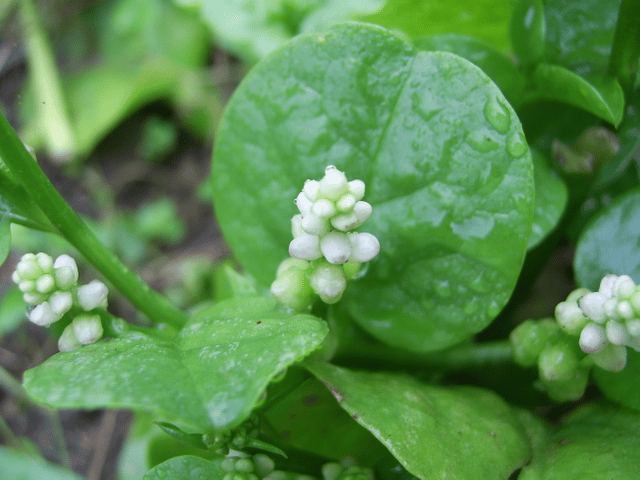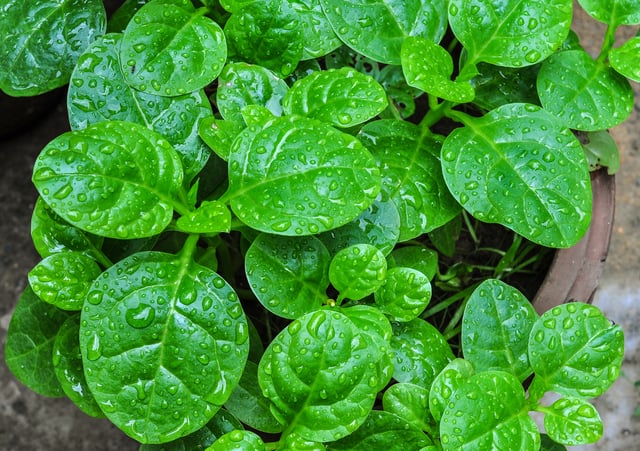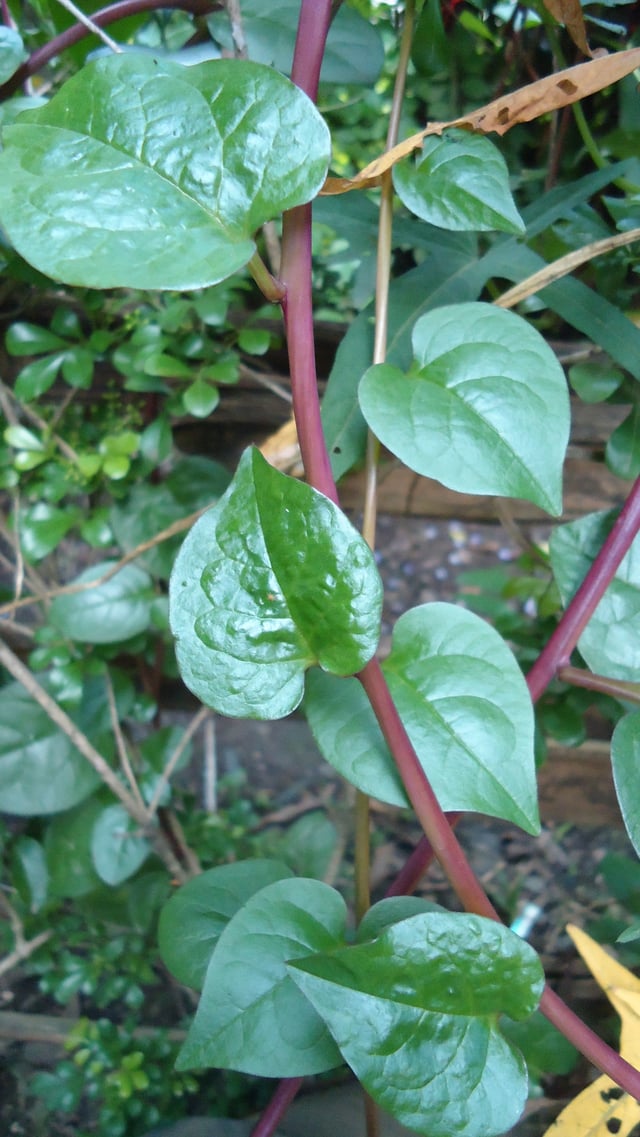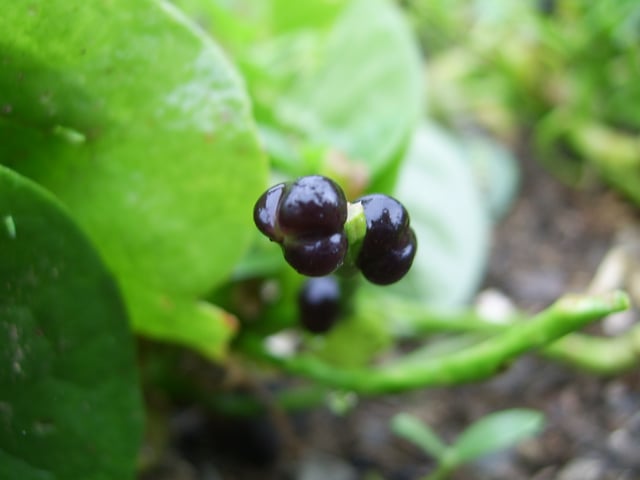Basella alba

Basella alba

| Malabar spinach | |
|---|---|
| Scientific classification | |
| Kingdom: | Plantae |
| Clade: | Angiosperms |
| Clade: | Eudicots |
| Order: | Caryophyllales |
| Family: | Basellaceae |
| Genus: | Basella |
| Species: | B. alba |
| Binomial name | |
| Basella alba | |
| Synonyms[1] | |
| |
| Nutritional value per 100 g (3.5 oz) | |
| Energy | 79 kJ (19 kcal) |
3.4 g | |
Fat | 0.3 g |
Protein | 1.8 g |
| Vitamins | Quantity%DV† |
| Vitamin A equiv. | 50% 400 μg |
| Thiamine (B1) | 4% 0.05 mg |
| Riboflavin (B2) | 13% 0.155 mg |
| Niacin (B3) | 3% 0.5 mg |
| Vitamin B6 | 18% 0.24 mg |
| Folate (B9) | 35% 140 μg |
| Vitamin C | 123% 102 mg |
| Minerals | Quantity%DV† |
| Calcium | 11% 109 mg |
| Iron | 9% 1.2 mg |
| Magnesium | 18% 65 mg |
| Manganese | 35% 0.735 mg |
| Phosphorus | 7% 52 mg |
| Potassium | 11% 510 mg |
| Zinc | 5% 0.43 mg |
Link to USDA Database entry [14] | |
| |
| †Percentages are roughly approximated using US recommendations for adults. Source: USDA Nutrient Database [15] | |

Leaves from West Bengal, India

A variety of Basella alba with deep red and purple stems in the Philippines

Malabar spinach fruits (Zhuji countryside (Zhejiang, China), 2005).
Basella alba is an edible perennial vine in the family Basellaceae. It is found in tropical Asia and Africa where it is widely used as a leaf vegetable. It is native to the Indian subcontinent, Southeast Asia and New Guinea. It is reportedly naturalized in China, tropical Africa, Brazil, Belize, Colombia, the West Indies, Fiji and French Polynesia.[1]
| Malabar spinach | |
|---|---|
| Scientific classification | |
| Kingdom: | Plantae |
| Clade: | Angiosperms |
| Clade: | Eudicots |
| Order: | Caryophyllales |
| Family: | Basellaceae |
| Genus: | Basella |
| Species: | B. alba |
| Binomial name | |
| Basella alba | |
| Synonyms[1] | |
| |
| Nutritional value per 100 g (3.5 oz) | |
| Energy | 79 kJ (19 kcal) |
3.4 g | |
Fat | 0.3 g |
Protein | 1.8 g |
| Vitamins | Quantity%DV† |
| Vitamin A equiv. | 50% 400 μg |
| Thiamine (B1) | 4% 0.05 mg |
| Riboflavin (B2) | 13% 0.155 mg |
| Niacin (B3) | 3% 0.5 mg |
| Vitamin B6 | 18% 0.24 mg |
| Folate (B9) | 35% 140 μg |
| Vitamin C | 123% 102 mg |
| Minerals | Quantity%DV† |
| Calcium | 11% 109 mg |
| Iron | 9% 1.2 mg |
| Magnesium | 18% 65 mg |
| Manganese | 35% 0.735 mg |
| Phosphorus | 7% 52 mg |
| Potassium | 11% 510 mg |
| Zinc | 5% 0.43 mg |
Link to USDA Database entry [14] | |
| |
| †Percentages are roughly approximated using US recommendations for adults. Source: USDA Nutrient Database [15] | |
Description
Basella alba is a fast-growing, soft-stemmed vine, reaching 10 metres (33 ft) in length. Its thick, semi-succulent, heart-shaped leaves have a mild flavour and mucilaginous texture. It is rich in vitamins A and C, iron and calcium. It has been shown to contain certain phenolic phytochemicals, and it has antioxidant properties.
It is also called Malabar Spinach. There are two varieties - green and red. The stem of the Basella alba is green and the stem of the cultivar Basella alba 'Rubra' is reddish-purple; the leaves in both cases are normally green. The stem when crushed usually emits a strong scent. Malabar Spinach can be found at many Asian supermarkets, as well as farmers' markets.
Soil and climate requirements
Basella alba grows well under full sunlight in hot, humid climates and in areas lower than 500 metres (1,600 ft) above sea level. The plant is native to tropical Asia.[5] Growth is slow in low temperatures resulting in low yields. Flowering is induced during the short-day months of November to February. It grows best in sandy loam soils rich in organic matter with pH ranging from 5.5 to 8.0.
Uses
In the Philippines, the leaves of this vegetable are one of the main ingredients in an all vegetable dish called utan that is served over rice. It is usually cooked with sardines, onions, garlic, and parsley.
In Karnataka Cuisine (Karavali and Malnad regions), the leaves and stems are used to make Basale Soppu Saaru/Curry (Especially in combination with Jackfruit seed) and soupy raita with curd. In Mangalorean Tuluva cuisine, a coconut based gravy called Gassi is paired with the Basella plant, making a delicacy called Basale Gassi to be eaten with rice dumplings called Pundi soaked overnight in the gravy, or with red rice. Some variations have tiny prawns, clams, horsegram or dried fish in the gravy as well. Beary Muslims of coastal Karnataka prepare Basalede kunhi Pindi (small rice dumplings smeared in gravy prepared from Malabar spinach and dried tuna ). In Bengali cuisine it is widely used both in a vegetable dish, cooked with red pumpkin, and in non-vegetarian dishes, cooked with the bones of the Ilish fish and may also be cooked with shrimps. In Andhra Pradesh, a southern state in India, a curry of Basella and Yam is made popularly known as Kanda Bachali Koora [Yam and Basella curry]. Also it used to make the snack item bachali koora bajji. In Odisha, India, it is used to make Curries and Saaga (any type of dish made from green leafy vegetables is called Saaga in Odisha). In the Western Ghats in Maharashtra, India, it is used to make bhaji (भजी). It is also known as daento or valchi bhaji in Konkani. A popular Mangalorean dish is "Valchi Bhaji and Shrimp - Curry". In Gujarat, fresh big and tender leaves are washed, dipped in besan mix and deep-fried to make crispy pakodas, popularly called "poi na bhajia".
The vegetable is used in Chinese cuisine. It has many names including flowing water vegetable. It is often used in stir-frys and soups. In Vietnam, particularly the north, it is cooked with crab meat, luffa and jute to make soup.
In Africa, the mucilaginous cooked shoots are most commonly used.[6]